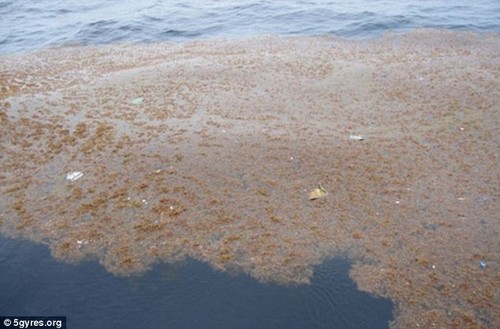Giant Floating Garbage Patch - confirmed in the Atlantic too.
by Sail-World/Daily Mail on 27 Feb 2010

Garbage patch in the Atlantic - aerial view SW
Polystyrene, thongs, bottle tops, and shotgun caps: There has been much publicity about the 'North Pacific Gyre Garbage patch', but now scientists have confirmed the existence of a giant garbage patch in the Atlantic Ocean as well.
The large floating patch of discarded plastic is north of the Caribbean and is a similar in volume to the 'great Pacific garbage patch' that lies in the middle of the North Pacific Gyre, a giant whirlpool caused by the currents of the ocean that collects floating objects into its centre.
Discarded plastic is known to harm seabirds and marine life, but Karen Lavender Law of the Sea Education Association said the problem in the Atlantic ocean had been 'largely ignored.'
Just some of the rubbish picked up during a sweep in the North Atlantic. Most pieces are only 1cm wide and can be swallowed by fish and birds. As the debris is so small it mingles in with the seaweed. Sea birds mistake the discarded plastic for food.
These revelations come after the results of a 22-year study were unveiled at the Ocean Sciences Meeting in Portland, U.S. During the study, the longest and most extensive record of plastic marine debris in any ocean basin, SEA undergraduates collected more than 64,000 tiny bits of plastic.
In a mammoth effort, scientists and students carried out 6,100 sweeps of the North Atlantic towing fine mesh nets behind a research vessel. More than half of these expeditions revealed floating pieces of plastic on the water surface.
This image shows the remains of albatross chicks mingled with the plastic junk they were fed by their parents. Thinking it was food, the adults picked it up from the vast rubbish patch in the Pacific and then brought it back to the nest
Researchers believe these fish died after swallowing bits of plastic found floating in the Atlantic Ocean
The researchers described the sheer diversity of what they had found in this synthetic soup in a voyage blog.
They wrote: 'We saw embedded in each patch a disturbing mosaic of plastic junk. We grabbed our nets and began fishing furiously, amassing a pile of bottle caps, shotgun shells, crates, toothbrushes, a boxer’s mouthpiece, and myriad unidentifiable chunks floated by, gently pulsating with the ocean’s currents.'
Dr Lavender Law said that most of the pieces of plastic were generally very small - about one centimetre across, and were accumulating fairly far north in the Atlantic.
The maximum 'plastic density' was 200,000 pieces of debris per square kilometre. It is impossible to measure the exact size of the patch as much of it floats beneath the surface.
'That's a maximum that is comparable with the Great Pacific Garbage Patch,' said Dr Law.
If you want to link to this article then please use this URL: www.sail-world.com/66835

